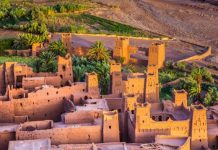As Morocco gears up to co-host the 2030 FIFA World Cup, the country’s National Ports Agency (ANP) is rolling out a major infrastructure overhaul to align its maritime gateways with international expectations. More than just meeting FIFA’s technical standards, the plan aims to position Moroccan ports as strategic, visible, and welcoming logistical hubs during the global event.
At the heart of this initiative is the FIFA Port Agreement 2030, a binding framework that brings together the ANP, FIFA, the Royal Moroccan Football Federation, and the Ministry of Equipment and Water. This agreement sets forth a wide array of legal, technical, and operational obligations that must be integrated into existing port operations and facilities.
Ports in key cities—Tangier-Ville, Nador Beni Ensar, Nador West Med, Saïdia, Casablanca, and Agadir—are at the forefront of this transformation. These locations will be required to meet strict benchmarks in terms of security, accessibility, logistical coordination, and hospitality. But Morocco’s ambitions go further than simply ticking boxes: the vision is to temporarily reimagine these ports as experiential spaces for fans, creating immersive environments that reflect the scale and spirit of the World Cup.
This logistics shift is part of a broader, trilateral effort between the tournament’s co-hosts—Morocco, Spain, and Portugal. Port authorities in the three countries are expected to work in lockstep, ensuring seamless coordination across borders. This includes aligning transportation operators, public security forces, and institutional partners.
To lead this transformation, the ANP will soon launch a public tender to recruit an external consultant. This expert will be tasked with two core missions. First, conducting a full strategic diagnostic to evaluate where Morocco’s ports currently stand relative to FIFA’s requirements. The assessment will cover infrastructure, service quality, traffic flow, digital connectivity, and governance. A port-by-port analysis, complemented by international benchmarking and a review of internal capabilities, will inform the blueprint.
From there, the agency will define clear roles for each participating port based on a unified and forward-looking strategy. Each scenario will consider logistical synergies, technical feasibility, financial impact, risk mitigation, and the overall visitor experience.
The second phase will bring this strategy to life through an actionable plan. This roadmap will outline physical upgrades, traffic management systems, designated fan zones, multilingual services, and even unconventional lodging options like floating hotels. The goal is to ensure that ports not only function efficiently during the tournament but also showcase Morocco’s modern maritime potential to the world.
To keep the project on track, the ANP will establish a dedicated program management office (PMO) for the 2030 World Cup. This team will be responsible for overseeing progress, coordinating between stakeholders, and steering communication efforts. A centralized unit, dubbed the Football World Cup 2030 Cell, will manage data reporting, align efforts across agencies, and lead change management to ensure full stakeholder engagement.
For the ANP, this isn’t just about preparing for a single event. The initiative is seen as a stepping stone toward long-term reform. The broader objective is to modernize port governance, elevate operational standards, and establish Morocco’s ports as regional benchmarks—both in terms of efficiency and international prestige.





